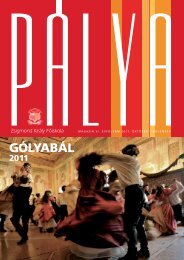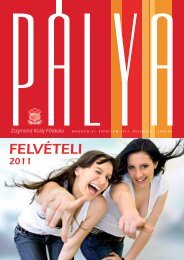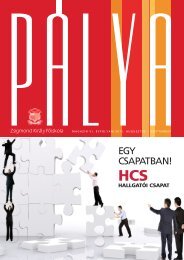Superman: Historical-Narrative Formation of a 20th Century Popular ...
Superman: Historical-Narrative Formation of a 20th Century Popular ...
Superman: Historical-Narrative Formation of a 20th Century Popular ...
You also want an ePaper? Increase the reach of your titles
YUMPU automatically turns print PDFs into web optimized ePapers that Google loves.
<strong>Superman</strong>: <strong>Historical</strong>-<strong>Narrative</strong> <strong>Formation</strong> <strong>of</strong> a <strong>20th</strong> <strong>Century</strong> <strong>Popular</strong>American Hero“Smallville”1
Table <strong>of</strong> ContentsAbstract.................................................................................................................................................3Introduction..........................................................................................................................................4Chapter 1: <strong>Narrative</strong> and Myth: Conceptualizing an American Superhero..........................................6Chapter 2: Good Fights Evil: The Mythic Hero <strong>of</strong> the Depression....................................................12Chapter 3: Lost in the Crowd, a Hero in Disguise.............................................................................16Chapter 4: <strong>Superman</strong> as the Embodiment <strong>of</strong> the American Dream....................................................20Conclusion..........................................................................................................................................25Works Cited........................................................................................................................................26Appendix 1: <strong>Superman</strong> Character Pr<strong>of</strong>ile...........................................................................................28Appendix 2: The <strong>Superman</strong> Logo......................................................................................................29Appendix 3: <strong>Superman</strong> in the Comics................................................................................................30Picture Sources...................................................................................................................................332
AbstractThe aim <strong>of</strong> this thesis is to show that the Great Depression <strong>of</strong> the 1930s had significant changes inAmerican social consciousness. One escape was presented through identifying with the pop culturalcomic book character, <strong>Superman</strong>, whose fictional life is rooted in real life situations. The doubleidentity: being both a superman and an ordinary person enabled the character to gain popularityrapidly and has become one <strong>of</strong> the most important American pop cultural icons. In this paper, Iintend to reveal that the main characteristics <strong>of</strong> <strong>Superman</strong> are created within the framework <strong>of</strong> theAmerican national myth. Thus the hero has been capable <strong>of</strong> constant rebirth and formation, alwaysadapting to the needs <strong>of</strong> the given epoch through its narrative devices.3
Introduction“The American hero lives in all <strong>of</strong> us…and if we are not all heroes, we are all hero ridden.Descendants <strong>of</strong> a legend, we persist in identifying with it” (Rollin 434). These two sentences sumup the meaning <strong>of</strong> <strong>Superman</strong> in American culture. He is a cultural icon that is known throughout theworld. The ‘S’ logo, see appendix 2, has become a symbol which represents all that is good andright. Hence it is common to see <strong>Superman</strong> as the character that embodies these. With <strong>Superman</strong> thecreation <strong>of</strong> modern age mythology in America has begun. But what exactly makes a character risefrom hero to myth? Some would say strength others spirit. Actually they are both right; the mythicalfigures are mostly strong men, yet the possession <strong>of</strong> outstanding physical power never made anyonea myth. Only when the hero stands up for a cause, when he uses his powers to make a differencecan he become an archetypal mythical hero. People needed someone through whom they could seethat the value system they believe in works. <strong>Historical</strong> models were laid down by the religion andeach era expanded upon these, if there was need to. Religion and mythology always went hand inhand, since through myths heroes were trying to live up to the legacy set by the religion. Throughtheir success people could relate more to their religion and could have faith that the value systemworks and it is worth living by it. All these heroes are defined by their era. The reason why<strong>Superman</strong> has grown so popular lies in the character’s built up, namely in representing the eternalvalues through which he has become the hero that all ages could relate to and aspire to be. In thispaper I will look at the origin <strong>of</strong> the Man <strong>of</strong> Steel and through approaching the character fromdifferent aspects from, how subsequent generation extended the whole notion <strong>of</strong> who <strong>Superman</strong> is, Iwill show why he can be seen today not only as a comic book hero or a popular culturalphenomenon but a symbol <strong>of</strong> America, and to go even further the founding myth <strong>of</strong> America as wellas the fulfillment <strong>of</strong> the American Dream itself.In the first chapter the mythological and psychological background <strong>of</strong> the comic hero<strong>Superman</strong> will be addressed. Myths are found in various cultures and are, at first sight, culturespecific.However, once compared, they reveal a number <strong>of</strong> common points. Like the charactersthey use, the way the stories are told and even their structure. <strong>Superman</strong> as a modern mythologicalcharacter shows these exact same patterns. The chapter will look at the psychological base <strong>of</strong> mythformation and fill the gap between the mythological hero and the superhero. The superhero'sappearance marks a stage where the traditional heroes could not provide the kind <strong>of</strong> moral supportthat was needed. The chapter will also deal with the medium that <strong>Superman</strong> appeared in, the comic4
ook. Every medium is defined more or less by the narrative techniques that it applies. Comics usea rather unique way <strong>of</strong> storytelling. They are not purely pictorial or literal for that matter, they are arather a hybrid <strong>of</strong> the two. It is important to note that the character appeared in other media as well,including various radio broadcast, televisions series, movies and even a Broadway piece. However,this paper has its focus only on the comic series as such.In the second chapter I will outline the historical context <strong>of</strong> <strong>Superman</strong>’s birth; the GreatDepression. Already in the 1920s there were signs <strong>of</strong> the upcoming catastrophe. Agriculture neverreally recovered from the 1890s depression. There was not enough market demand for Americangoods, which was only deepened by overproduction. Wages were constantly decreasing, only thestock market index was rising. Mob rule and gangster activity were common while the workingmen <strong>of</strong>ten had to stand in bread lines. The notion <strong>of</strong> justice was swinging out <strong>of</strong> balance and peoplewere in deep need <strong>of</strong> some spiritual and moral guidance. Previous hero images did not meetrenewed social circumstances. This is the context <strong>Superman</strong> was born into in 1938 and took on themantel <strong>of</strong> the national hero. The character had such a deep impact because it was suggested through<strong>Superman</strong> that this state is attainable by an average man as well.The third chapter will elaborate on the relationship and narrative solutions <strong>of</strong> assimilation.<strong>Superman</strong> has a double identity; Clark Kent, the mild-mannered reporter, and <strong>Superman</strong>, the Man <strong>of</strong>Steel. Duality is the key concept in understanding and unfolding <strong>Superman</strong>. This chapter willapproach the issue through the creators <strong>of</strong> <strong>Superman</strong>: Jerry Siegel and Joe Shuster. They were bothsons <strong>of</strong> Jewish immigrants and second generation Jewish-Americans. Assimilation was afundamental problem their generation faced. How true they can remain to their ancestral culture andhow they can also be Americans at the same time are questions that every minority group has to askin the wake <strong>of</strong> the relocation experience. Renationalization, the establishing <strong>of</strong> enclaves was oneanswer. Denationalization accepting and giving in to the Melting Pot was another solution but as<strong>Superman</strong>’s analysis shows it was not the only one. <strong>Superman</strong> as a common national mythologywas representing an ideology that was able to fuse all these aspects together.The fourth chapter will show how the notion <strong>of</strong> the American Dream is represented in thestory <strong>of</strong> <strong>Superman</strong>. Ideology meets ideology and the chapter will explain how these two areintertwined. <strong>Superman</strong> was sent to Earth from the distant planet <strong>of</strong> Krypton then he was found andraised in rural Kansas. After finishing school in Smallville, Kansas he moved to Metropolis. Thestructuring and sequence are built upon the very core American success story saying that you canbecome a respected member <strong>of</strong> the society but you have to work hard for it; it does not matter fromwhere you are. <strong>Superman</strong>, as an immigrant is a deeply relatable character since most <strong>of</strong> the5
Americans feel they share immigration as a background experience. Through <strong>Superman</strong> one <strong>of</strong> theclearest fulfillings <strong>of</strong> the American Dream are shown. Via keeping two diverse ways <strong>of</strong> achievingthis notion in balance the American Dream is embedded in the life <strong>of</strong> the character.The appendices at the end <strong>of</strong> the paper illustrate the character from three points. In appendix1 a character pr<strong>of</strong>ile <strong>of</strong> <strong>Superman</strong> is given. Appendix 2 shows the changes that were made to thesymbol <strong>of</strong> <strong>Superman</strong>, the S shield. Appendix 3 provides examples from the <strong>Superman</strong> comics.6
Chapter 1: <strong>Narrative</strong> and Myth: Conceptualizing an American SuperheroThe term mythology has a dual function; it is primarily used for the study <strong>of</strong> myths as a principlebut it also stands for the body <strong>of</strong> myths <strong>of</strong> a given culture (Kirk). The study <strong>of</strong> myths can be tracedback in history to the Presocratics, who saw myth as being based on historical events. This theorywas not well received by their contemporaries; Plato for example was very much against it (Segal).Mythology gained increased scholarly attention only in the 19 th century (Segal), yet these werestrongly biased theories. The turning point was brought about in the 20 th century, when mythologywas not seen as an “outdated counterpart to science” any more (Segal 67). Various theories haveemerged since, regarding the functions <strong>of</strong> what myths can fulfill and where their origins may lay.Three <strong>of</strong> these will be touched upon within the frames <strong>of</strong> this study. William Doty argues that mythsare essentially based on historical events. The quality <strong>of</strong> these events, whether positive or negative,was increased through the repeated storytelling and those who enacted them slowly assumed theroles <strong>of</strong> gods. This approach is called euhemerism, because <strong>of</strong> Euhemerus, a Presocraticmythologist, who had proposed the idea (Oxford Dictionary <strong>of</strong> World Religions). Another way <strong>of</strong>looking at myths is through allegories. According to this theory the origins <strong>of</strong> myths can be tracedback to natural phenomena (Segal). Closely connected to allegories is the personification <strong>of</strong>inanimate objects as a possible origin <strong>of</strong> myths (Bultfinch).None <strong>of</strong> the concepts, mentioned above, exclude each other. A myth can be just as muchallegorical as personified. It is assumable that these processes happened simultaneously. Somecultures may have preferred one form <strong>of</strong> myth creating over the other but this did not result in adifferent outcome. When comparative mythology as a field <strong>of</strong> study appeared it had the goal to finddifferences and similarities between the mythologies <strong>of</strong> the cultures whose myths we were able tocollect. A number <strong>of</strong> mythologies were compared with and interesting conclusion. Even though thefigures <strong>of</strong> these myths were different, they were essentially very similar in nature. Their differencewas the culture dependent part, meaning how the stories were built up, yet the inborn qualities <strong>of</strong>the characters appeared to have a universal value. The differences were in the how and not in thewhat. Concerning the process <strong>of</strong> myths creation, if myths are abstractions <strong>of</strong> their originalcounterpart, than what is left after the comparative analysis is an archetype.The 20 th century began with a turn toward the inside in the analysis <strong>of</strong> the humanpersonality along the approach advocated by the psychoanalysis <strong>of</strong> Sigmund Freud. According toFreud the psyche is constituted on three levels, the Id is the biological component <strong>of</strong> our personality,7
above it there is the Ego, the psychological component and on the highest level, the Superego, beingthe social component <strong>of</strong> our personality. The Swiss psychologist, Carl Jung continued to work onFreud's dream model but only as a starting point. They both shared the point that dreams hold manyanswers to the understanding <strong>of</strong> the individual psyche, but Jung was keen on finding out whetherdreams may also reflect collective ideas.Jung studied myths <strong>of</strong> different cultures extensively and believed that the driving forcebehind the constant presence <strong>of</strong> myths throughout the centuries is to be found in a collectivelyshared set <strong>of</strong> ideals, which are not culture specific but rather universal. Jung's theory goes asfollowing:My thesis then, is as follows: in addition to our immediate consciousness, which is<strong>of</strong> a thoroughly personal nature and which we believe to be the only empiricalpsyche (even if we tack on the personal unconscious as an appendix), there existsa second psychic system <strong>of</strong> a collective, universal, and impersonal nature which isidentical in all individuals. This collective unconscious does not developindividually but is inherited. It consists <strong>of</strong> pre-existent forms, the archetypeswhich can only become conscious secondarily and which give definite form tocertain psychic content (43).The patterns which each individual has in his/her unconscious is the collective unconscious. ClaudeLévi-Straus argued that these patterns in the mind are particularly visible when dealing withopposites (e.g. good-bad, light-darkness). They essentially reflect unconscious feelings and urges.Jung called the unconscious psychological forces, that are innate in each human, archetypes. Thusthe consequence can be drawn that myths are the effort to bring the unconscious patterns intoculturally manifestable forms. The archetypal forms are traceable in myths without furtherdifficulties and are claimed not to have cultural dependence, hence the archetypal characteristics <strong>of</strong>heroes are known rather inherently.Myths provide the context in which the unconscious mental patterns can be expressed andthe heroes <strong>of</strong> myths are the projectional surfaces that are provided by the medium. The reason whymythological heroes vary on such a scale is in connection with the differences in the mental patternsand the need <strong>of</strong> trying to get a hold <strong>of</strong> them. By the circulation <strong>of</strong> myths, in the masses, the ideasexpressed are constantly reproduced and recreated generation after generation.<strong>Superman</strong> as a superhero stands at the meeting point <strong>of</strong> various ideologies. TheEncyclopedia <strong>of</strong> American Studies proposes the following definition for superheroes:The superhero has most <strong>of</strong>ten been labeled a cultural descendant <strong>of</strong> the classicalepic hero—the twentieth century's answer to Hercules, Robin Hood, and KingArthur. In simplest terms the superhero is a larger-than-life figure that fights againstthe forces <strong>of</strong> evil. As described by Robert Jewett and John Shelton Lawrence in8
The American Monomyth, he (or she) is distinguished by disguised origins, puremotivations, a redemptive task, and extraordinary powers. He originates outside thecommunity he is called to save, and in those exceptional instances when he isresident therein, the superhero plays the role <strong>of</strong> the idealistic loner. His identity issecret, either by virtue <strong>of</strong> his unknown origins or his alter ego, his motivation aselfless zeal for justice.If the superhero is indeed the “descendant <strong>of</strong> the classical epic hero” the making <strong>of</strong> myths has neverreally come to an end point. Rather with the appearance <strong>of</strong> new media new ways were found toexpress them. During this formal change the content remained but adding multiple identities to onehero opened up a whole new cultural frontier. Ordinary and extraordinary were fused in onecharacter. Yet without causing confusion in the reader it even enhanced the overall experience. Thesuperhero continued the tradition <strong>of</strong> the mythological heroes, meaning that he still felt like hestepped out <strong>of</strong> the collective unconscious, but it was not merely a projection, rather the ordinary, theeveryday part <strong>of</strong> the character took this role upon itself. One could project their own personality onthe ordinary half believing that they have the ability to grow beyond their ordinariness and can giverise to the “super” contained within. <strong>Superman</strong> was the character that pioneered this specificpsychological process.The narrative dimension in the case <strong>of</strong> <strong>Superman</strong> is the comic book. The comic book applies arather unique way a storytelling, one that is both differentiable from the other media yet tillrepresents a fusion. To think <strong>of</strong> the comic books and comic strips as a 20 th century phenomenon isonly partially true, only the format can be truly considered contemporary. The storytelling which itapplies, has deep historical roots.It is possible to view narrative from several perspectives.Ryan proposes five approaches todefine what a narrative is: the existential, the cognitive, the aesthetic, the sociological and thetechnical approach (2). The cognitive approach is interested in identifying the operations <strong>of</strong> themind that enables us the constructing <strong>of</strong> narratives. The instrumental approach views narratives asthe most important tool <strong>of</strong> manifesting our thoughts. The aesthetic one deals with the textsthemselves as a whole whereas the technical approach analyzes the narratives through itscomponents separately. These do not exclude each other, quite the contrary, together they canprovide a much more comprehensive picture. The one that provides a very core explanation <strong>of</strong> hownarratives work and, hence the one that will receive the most emphasis in this study, is theexistential type. Which: “tells us that the act <strong>of</strong> narrating enables humans to deal with time, destinyand mortality; to create and project identities; and to situate themselves as embodied individuals ina world populated by similarly embodied subjects” (Ryan 2). It follows that man has been, since thebeginning <strong>of</strong> history, trying to make sense <strong>of</strong> the world around him. Telling stories and preserving9
them served as a backbone for forming communities, no matter <strong>of</strong> what size. The members wereprovided with different identities with which they could place themselves within a community.Stories are easily associated with writing. Oral tradition, by definition, did not requireliteracy but was still to a large extent textual. <strong>Narrative</strong>s are basically codes themselves in form <strong>of</strong>texts. Encoded they result in a mental image, a cognitive construct, put together by the interpreter(Ryan). Where the textual dimension cannot work the cognitive dimension has to take over. Hencewhat was needed was a 'silent' form <strong>of</strong> narrating. Pictorial art has been given this role, whichenjoyed popularity throughout history.Every medium that in one way or other tells a story is defined by the narrative device that ituses. There have been numerous attempts to pin down the narrative <strong>of</strong> comics. Mostly it is seen aspictorial art purely; not accounting for the literal dimension that is also contained within themedium. Robert Hervey proposes that comics posses a “narrative told by a sequence <strong>of</strong> pictures”.Greg Hayman and John Pratt see comics as “juxtaposed pictures that comprise a narrative”. ScottMcCloud views the medium as consisting <strong>of</strong> “images in deliberate sequence”. This sequence <strong>of</strong>pictures is the major organizing force and hence what provides the narrative structure <strong>of</strong> the comics.However, it is also important to remember that pictures are only half <strong>of</strong> the narrative that the comicsapply, there is the literal dimension as well. Pratt argues that comics are a hybrid art form,incorporating both the literal and pictorial dimension to successfully construct a narrative structure.The question is how they cooperate. Pratt continues that comics are “essentially pictorial”, but thisis only in certain cases true. Neither the literal or the pictorial dimension would make sense withoutthe other. Comics use a distinctive form <strong>of</strong> narration that is unique to the medium. Unique in thesense that it addresses more senses not only the visual.Like in the textual media it is <strong>of</strong>ten more important in terms <strong>of</strong> narration what is left out asopposed to what is included. Filling the gaps between the pictures is essentially the same as readingwithin the lines in a textual narrative. McCloud argues that “by de-emphasizing the appearance <strong>of</strong>the physical world in the favor <strong>of</strong> the idea <strong>of</strong> form, the cartoon places itself in the world <strong>of</strong>concepts” […] “and since viewer-identification is a specialty <strong>of</strong> cartooning, cartoons havehistorically held an advantage <strong>of</strong> breaking into world popular culture” (41-42). His conclusion isthat this way the message itself is getting the focus from the reader and not the message carrier.Basically the audience is presented with a world in which the projection <strong>of</strong> the self is not justpossible but a subconscious part <strong>of</strong> the narration process. This world is presented both on the textualand visual level and the reader puts the bits and pieces together to arrive at his/her own cognitiveconstruct. In my point <strong>of</strong> view McCloud’s account is the one that defines the comics as being10
constructed along the cognitive dimension and is the one that this paper will use as amethodological background.That comic books are associated with American culture is not a coincidence. However, itwould be a mistake to assume that they are only to be found there, but in the frames <strong>of</strong> this paperthe focus will solely be on one <strong>of</strong> the American comics, <strong>Superman</strong>. Since comic books and comicstrips are by definition popular cultural media a large number <strong>of</strong> people have access to them.11
Chapter 2: Good Fights Evil: The Mythic Hero <strong>of</strong> the DepressionAmerica in 1929 was a prosperous country. People were optimistic, enjoyed their lives and thoughtthat nothing could change this. This is the typical image <strong>of</strong> the Roaring Twenties we usually share.Nevertheless the vast majority <strong>of</strong> the people lived in poverty, already before the crisis. There werequite a few signs <strong>of</strong> the upcoming crisis. The reasons were plenty, but the most important were:economic weakness, under consumption and thus unequal distribution <strong>of</strong> wealth, this wealthconcentrated in the hands <strong>of</strong> large corporations. The previous crisis, in the 1890s, that had affectedmostly the agriculture was not over fully without leaving the economy severely damaged.Overproduction raised problems as well. Still for many the Twenties ended in a shock which wasmainly due to the government’s attitude towards the crisis. On October 29, also known as BlackTuesday, the stock market crashed and brought America to her knees which later resonatedthroughout the whole world. The crisis escalated due to the already existing international economictroubles and the failure <strong>of</strong> federal policies.The crash further worsened by the devastating depression that it unleashed. “Overall, theeconomic catastrophe aggravated old tensions: labor versus capital, white versus black, male versusfemale” (Norton, Katzman, Escott, Chudac<strong>of</strong>f, Paterson, and Tuttle 722). Unemployment rateskyrocketed, and only the wealthy remained unaffected by the crash. People sought help from thegovernment. Even though President Herbert Hoover used the state apparatus more than any otherpresident before him, he did not go beyond a certain line. He believed so much in one <strong>of</strong> the keyAmerican values – liberty - that the people felt he had failed them. However, no social unrest wasunleashed during the crisis. People “did not turn to violent revolt or political extremism. Theirrootedness in the past – their traditionalism – would not allow them” (Norton et al. 710). But thepublic definitely reacted; President Hoover did not get reelected in 1932. The Democratic candidateFranklin Delano Roosevelt became the new president and his New Deal was able to keep the crisisat least between certain limits (Norton et al).The Depression Era brought about another important change, which was how Americansunderstood themselves as a community. “One symptom <strong>of</strong> the new self-censure lay in the fall <strong>of</strong> thetraditional heroes” (Fox and Pope 595). The hero <strong>of</strong> the era up to the Great Depression was thesuccessful businessman. Yet, where millions became unemployed this image could no longer be <strong>of</strong>help. To worsen the situation this was also the “Golden Age <strong>of</strong> Bank Robbery”. Gangsters likeJohnny Dillinger, Bonnie and Clyde, Al Capone and “Baby-Face” Nelson challenged the very12
concept <strong>of</strong> justice. As the unemployed were standing in bread lines the criminals were robbingbanks and making money. Some <strong>of</strong> them, for example Johnny Dillinger, became folk heroes, eventhough the latter was leading list <strong>of</strong> public enemies. At some point it seemed as if it was more worthbeing one <strong>of</strong> the bad guys, indicating moral crisis.Even though FDR’s New Deal tried to stop the Great Depression this could only be a partialresolution to the problems <strong>of</strong> the age. People needed something to give them hope, to make themforget this crisis, if only for a limited period <strong>of</strong> time. Movies were such an escape. “Although a third<strong>of</strong> the nation’s movie theaters shut down in the early years <strong>of</strong> the depression, millions <strong>of</strong> Americansstill paid to see Hollywood’s latest <strong>of</strong>ferings” (Norton et. al. 720). All the classic gangster moviessuch as Little Caesar, The Public Enemy, The Petrified Forest, Angels with Dirty Faces, and TheRoaring Twenties were made in this era when these gangsters were active. Even though thesemovies might seem as homages to them, they in fact expressed the public’s outrage provoked bytheir crimes. Little Caesar had one <strong>of</strong> the bloodiest death scenes, which were to symbolize thepeople’s rage against these criminals and their hope that their time will soon be over. Being a villaininstead <strong>of</strong> a hero was more tempting because <strong>of</strong> the increasing rate <strong>of</strong> uncontrolled criminal actions.Society ended up admiring anti-heroes because <strong>of</strong> the lack <strong>of</strong> traditional hero images. Because <strong>of</strong>the urging need to balance the notion <strong>of</strong> justice, especially in this time <strong>of</strong> despair.<strong>Superman</strong> actually did not start out as a good guy at all when he was first imagined. JerrySiegel and Joe Shuster created in 1932 a mail-order periodical called Science Fiction (Appendix 2).These were short stories about the length <strong>of</strong> eight-ten pages. Inside there was a story called Reign <strong>of</strong>the <strong>Superman</strong> which was about a bold madman who tried to use his telepathic abilities to conquerthe world. The term ‘<strong>Superman</strong>’ was coined by German philosopher Friedrich Nietzsche some fiftyyears before the first publication <strong>of</strong> <strong>Superman</strong>. He mentions it as the “Übermensch” in his bookThus Spoke Zarathustra (Salter 421). This concept referred to an upper state <strong>of</strong> being which is in theNietzschean evolution attainable by ordinary man as well. This could have been an influentialideology on the creators <strong>of</strong> <strong>Superman</strong>, since a few months after publishing the story Jerry Siegelbegan to rethink the concept and shifted the character from evil to good. Also instead <strong>of</strong> telepathicabilities he would have physical strength.According to the original plot <strong>of</strong> the comic <strong>Superman</strong> was born as Kal-El on a distant planet,Krypton, which is described as very similar yet also different from Earth. His father, Jor-El, was aleading scientist on Krypton who discovered that the planet would soon explode. Together with hiswife Lara he started to prepare a spaceship to save as many people as possible, but it was too lateand they could only save their own infant son. With the planet exploding behind him baby Kal-El13
was launched towards Earth. Here he landed in rural Kansas where he was found by Jonathan andMartha Kent. Growing up in Smallville he realized that he had extraordinary powers, which he hadsworn to use it for truth, justice and the American way. He moved to Metropolis where he became anewspaper reporter, and developed his dual identity. The mild mannered Clark Kent was thedisguise; whenever help was needed <strong>Superman</strong> arrived.<strong>Superman</strong>’s publication life began in 1936. Jerry Siegel and Joe Shuster, sons <strong>of</strong> Jewishimmigrants, had been trying to sell a comic strip they created to newspapers about a super-strongalien who fights injustice and stands up for the people. After two years National Periodicals, todayknown as DC, accepted their story and made <strong>Superman</strong> the lead character <strong>of</strong> the latest comic bookseries; Action Comics. From the moment <strong>Superman</strong> appeared in Action Comics in summer 1938(Appendix 2) it was a huge success (Look, Up). It is universally true for comics that the plots arebuilt up from real life happenings. This was the case for <strong>Superman</strong> as well and how they used itmade the public really react. “We are a nation that is new to this concept <strong>of</strong> urbanization and urbancrime and <strong>Superman</strong> was originally created as a social crusader” historian Mark Wade put it (Look,Up). <strong>Superman</strong> was different from the character that we know today. First <strong>of</strong> all he did not fly andhis strength was not as great as it later would become, neither did he have his heat- or x-ray vision.But what he lacked in powers he made up in attitude. The reason why Jerry Siegel and Joe Shusterequipped <strong>Superman</strong> with such an enormous strength is because there were so many problems thatwould have been impossible for only one man to face. As Eco points out “<strong>of</strong>ten the hero’s virtue ishumanized through his powers” (14), meaning that we equip our heroes with what we lack. In anindustrial society like America this virtue would definitely be strength. Plus with the problems thatpeople had to face everyday morality was added as well.There was another trend developing in the Depression Era storytelling, the rise <strong>of</strong> thecommon man. In stories like John Steinbeck’s Grapes <strong>of</strong> Wrath where a family is doing their besttrying to escape the Depression, the virtues <strong>of</strong> common people were emphasized. This theme wasput to use by the creators <strong>of</strong> <strong>Superman</strong> as well. His alter ego Clark Kent is a character who appearsto us as modest, timid, near-sighted and not overly intelligent young man. This is what gives<strong>Superman</strong> his biggest virtue, since the hero has to be believable and relatable at least to someextent. <strong>Superman</strong> alone was not enough for this; he needed to have an alter ego. Clark Kentrepresented the average American: he was working hard, having competition at work and a rigidboss. But he is only the disguise to the hero, which was to say that even though one might seem likean average person with ordinary strength all can be like <strong>Superman</strong>. “Through an obvious process <strong>of</strong>self-identification, any accountant in any American city feeds the hope that one day, from the14
slough <strong>of</strong> his actual personality, a superman can spring forth” (Eco 15). This double narrative, beingpartly a detective story and a hero’s narrative is what made this character believable. With this thecreators were able to make <strong>Superman</strong> relatable and brought him down to the ground, within thereach <strong>of</strong> the common American person.<strong>Superman</strong> grew far greater than even his creators could have imagined. In 1939 <strong>Superman</strong>made the jump from comic book to newspaper comic strip, and soon millions <strong>of</strong> Americans werereading his adventures. Urbanization was still very much in progress, and the city was seen as adangerous place, which has not changed ever since. <strong>Superman</strong> faced the fears <strong>of</strong> the time, foughtenemies and won, he always stood his ground. Both fighting the fears <strong>of</strong> the nation within andoutside the borders. It was crucial to have such a character to appear during the Great Depression.America needed a unifying mythology <strong>of</strong> her own, regardless <strong>of</strong> race and religion. <strong>Superman</strong>established the concept that even though one may be less strong physically or mentally, this doesnot matter because deep inside all can be supermen. “Winning is key to the American psyche” (Faul9) and it is coded in the nation as a whole. Though <strong>Superman</strong> is a fictional character he was able togive the people more hope than any real person could at the time <strong>of</strong> the Depression and long after.15
Chapter 3: Lost in the Crowd, a Hero in Disguise<strong>Superman</strong> is a character with a double identity who embodies all that is good in the world anddefends it. That he is both Clark Kent and <strong>Superman</strong>, urban and rural, conformist and nonconformisthas deep roots that made this character rise from a superhero to the superhero. Tounderstand why he ended up being the most virtuous being it is important to examine thebackground <strong>of</strong> the creators <strong>of</strong> <strong>Superman</strong> – Jerry Siegel and Joe Schuster, who were both sons <strong>of</strong>Jewish immigrants and had first hand experience in having an ethnic background. Ethnicity is a keyconcept here in understanding both the origin and the success <strong>of</strong> <strong>Superman</strong>. Ethnicity is used torefer to a group a people who by having the same language, religion, heritage or a shared culture areable to identify with each other (Seidner). America is famous for having a large number <strong>of</strong> ethnicgroups living within its borders and Jewish Americans have been in North America since earlycolonial times.They were among the first groups <strong>of</strong> people to arrive in the New World and with no lessreason but to escape living as minorities (Gleason). This universally applied to all the Jewishcommunities, no matter where they were living. The immigration came in waves which weregaining size and mass more the closer they were to the pre-Depression years. The sooner theyarrived the better chances they had in succeeding. Having immigrated from different countries alsomeant that there were significant differences between them in a number <strong>of</strong> ways. “Language wasone index <strong>of</strong> this diversity” (Goren 571), these <strong>of</strong> course led to differences between these groups.Those who arrived before the mass immigration waves established themselves and were also able togain public respect; like the German Jews. They have been known to be skilled lawyers and werealso holding a few well known newspapers (Gleason).The eastern European Jews were arriving in large numbers, without any proper educationand with very little or no material possession whatsoever. They did not have any real likelihood toestablish themselves as the German Jews have done it before them. Most <strong>of</strong> the eastern EuropeanJews were heavily concentrated in the Lower East Side <strong>of</strong> Manhattan “which contained the largestnumber <strong>of</strong> Jews ever assembled in one place” (Sowell 80). In such heavily populated ghettos onehad a very limited number <strong>of</strong> possibilities, which were mostly only manual jobs. This situation wastypical for the first generation <strong>of</strong> American Jews in the Lower East Side. However, the secondgeneration had more opportunities and was also able to break out <strong>of</strong> the unskilled worker’s classand enter the white collar pr<strong>of</strong>essions. Nevertheless, the means <strong>of</strong> this breakout varied on large16
scale.The Jewish immigrants were but only one <strong>of</strong> the many different groups to arrive and settle inAmerica. This cultural divergence was even more visible in the larger cities, especially on the eastand west coast. Each immigrant group had its own neighborhood. Differences in origin, languageand religion divided them but they all had one factor in common. They had to face the choice <strong>of</strong>“renationalization or denationalization” (Gleason 15). This meant basically that they either shouldwork on developing a nation <strong>of</strong> their own in America or should become Americanized and by doingso organize their lives according to the American values. It is obvious that even if these migrantgroups wanted to obey this need, which they did not, it would have been impossible to establishenclaves within America. Most <strong>of</strong> them were trying to remain true to their original culture but thesecond generation was more oriented toward becoming assimilated into the mainstream culture. Theties with the parent culture remained as well so a dual cultural identity was established.Immigrants who came to America have been exposed to a culture different that they wereused to in their homelands. Getting acquainted with this new culture required time. Through theiradaptation period they <strong>of</strong>ten retreated into ethnic enclaves, a little piece <strong>of</strong> the mother country. Thesecond generation was both same and different to their parents. “The younger generation wasEnglish-speaking (<strong>of</strong>ten bilingual) and so was less tied to the lower east side by Old World languageand culture” (Sowell 89). This is where we can see the cultural dualism unfolding. As children eachgroup’s members were exposed to the culture surrounding them. In most cases this was only oneculture, like in the case <strong>of</strong> the recent European immigrant Jewish community this was the Jewishculture in the lower east side <strong>of</strong> Manhattan. This became the inspiration for the city calledMetropolis, appearing later in <strong>Superman</strong>’s life. Yet when the second and later generations weregrowing up they needed to find a way out <strong>of</strong> these heavily populated areas which meant acceptingwork opportunities <strong>of</strong>ten in the other half <strong>of</strong> the country.Jerry Siegel the writer half <strong>of</strong> the <strong>Superman</strong> creating duo was the son <strong>of</strong> a Lithuanian-Jewishimmigrant (Look, Up). His father was a manual worker who encouraged his son’s intellectualdevelopment. Joe Schuster lived among similarly poor conditions as his later to be <strong>Superman</strong> coinventorand the one to present their ideas on the visual level. Both were second generation JewishAmericans. They both visited the Glenville High School in Cleveland, Ohio, which is where theymet in 1931. They shared the same interest, such as adventure stories, science fiction, pulpmagazines and comic strips (Look, Up). They were working on the school newspaper together, withJerry as writer and Joe as the illustrator. The road they went along eventually ended with theirgroundbreaking ‘<strong>Superman</strong>’ project.17
The journey <strong>Superman</strong> made represents what the parents <strong>of</strong> the creators and <strong>of</strong> course anyimmigrant went through, which is <strong>of</strong> crucial importance to <strong>Superman</strong>’s later progress. <strong>Superman</strong> isthe last survivor <strong>of</strong> the planet Krypton. His father launched him in a spaceship to Earth where thebaby Kal-El (<strong>Superman</strong>’s original Kryptonian name) would have a real chance to survive. Hearrived in Kansas, which in the central <strong>of</strong> the United States and by this symbolic act it is shown thatthe idea <strong>of</strong> the American exceptionalism is one <strong>of</strong> the key notions in <strong>Superman</strong>’s life, drawing fromthe consciousness <strong>of</strong> his creators. It is here, in Smallville, Kansas, where he is raised by Martha andJonathan Kent, a farmer couple. Here Clark Kent (the name which was given to him by his earthlyparents) experiences his multilevel origin. He gets to know the core rural-small town Americanvalues. Growing up in the small town <strong>of</strong> Smallville he also began to recognize that he is differentfrom the other people around him. He has powers that allow him to achieve higher goals. This iswhere the crucial turning point lies in the evolution <strong>of</strong> any super powered character or anyone whodiscovered that there is a power difference between him and the rest <strong>of</strong> the society. The question isplainly set how to go on from here. Clark Kent became <strong>Superman</strong> because <strong>of</strong> how he was raised,because <strong>of</strong> the American values.Clark Kent began working on his double identity already in Smallville but concluded it inthe city <strong>of</strong> Metropolis. The process <strong>of</strong> leaving the rural home to seek possibilities in the urbanjungle <strong>of</strong> Metropolis is also embedded in the era’s culture and history in a number <strong>of</strong> ways. First,this is exactly the same process which most <strong>of</strong> the second generation immigrants went through.Second, the first decades <strong>of</strong> the 20 th century were also the time <strong>of</strong> the urbanization. Third, this wasthe era which witnessed in literature the rise <strong>of</strong> the common man. All these factors were fusedtogether in the double identity which is <strong>Superman</strong> and Clark Kent. When we unite these we can seea character who is balanced by oppositions. This balance is held up by the two very differentidentities that are working together; but one is only a mask, a cover. <strong>Superman</strong> is the original andClark Kent is the costume, yet one that is needed for <strong>Superman</strong> to be relatable. A modern age mythwas created.The Kryptonian self was denationalized in <strong>Superman</strong> but as the character progressed he feltthe need to learn more about his origin. But this did not mean that <strong>Superman</strong> wanted to ‘kryptonize’America so to say. <strong>Superman</strong> established a place called Fortress <strong>of</strong> Solitude on the South Polewhere he could research his Kryptonian origin (Look Up). It was meant to be a reminder to all theAmericanized minorities in regards to where they come from. There is a need for them to knowtheir heritage. This again could by applied not only for the second generation Jewish Americans likethe creators <strong>of</strong> <strong>Superman</strong> themselves were but to all the minorities in a similar situation. Even18
though this is only a small detail it adds an interesting new shade to all that what <strong>Superman</strong> issupposed to embody when we see it through the minorities. Yet it could also suggest that there wasno place to apply their culture in the American mainstream. It suggests that there is no need to gettoo Americanized. However, America has always been a multi-ethnic culture that is constantlychanging and expanding and in this sense new layers can constantly be added. The melting pottheory is also applicable in the case <strong>of</strong> whom <strong>Superman</strong> embodies.The melting pot is a metaphor referring to the assimilation process the immigrants gothrough when arriving in America. Through adding and taking away cultural features the meltingpot is the process itself since immigrants ‘enter’ it and Americans are the ‘outcome’. In cultureswith a longer cultural past there are examples in the folk tales and mythology about what makes thatparticular nation the one it is and where the differences lie between them and others whencompared. The melting pot was to establish the so called proto-American. This common mythologyacts as a binding element. Comparing this with the definition <strong>of</strong> the melting pot that Gleason gaveseeing it as “a symbol for the process whereby immigrants are absorbed into American society andsomehow changed into Americans” (3) this becomes a unifying process but it is such in variousways. It is not detailed what counts as American so each group can add their values as their sumcould end up as the common mythology that has been missing since Americanization is a processwhich happens as an interaction between the people. “’The real American’- the fusion <strong>of</strong> all races,the coming superman – had not yet made this appearance” (Gleason 6). <strong>Superman</strong> is in many waysthe ultimate immigrant. The character <strong>of</strong> <strong>Superman</strong> with its duality and multiple layers is what wecould call a solution to the melting pot symbol. <strong>Superman</strong> represents the values <strong>of</strong> both rural andurban communities and both that <strong>of</strong> an immigrants and mainstream Americans. He can be related toregardless to religion, race or even gender. He sums up what it means to be present at all theselevels while giving his best and holding his ground. Thus, he may become the person that couldchallenge the necessity <strong>of</strong> assimilation, the common national mythological figure.19
Chapter 4: <strong>Superman</strong> as the Embodiment <strong>of</strong> the American Dream<strong>Superman</strong> embodying the American Dream is an ideology embodying an ideology. Ideologies canbe seen as received consciousness, meaning that behind an ideology the main purpose is to <strong>of</strong>ferchange in society and adherence to a set <strong>of</strong> ideals where conformity already exists. <strong>Superman</strong>became not simply a moral crusader but a guardian <strong>of</strong> the core values, as an agent <strong>of</strong> the status quo<strong>of</strong> the nation, keeping these at their place. <strong>Superman</strong> embodies America the problems he faces, thevillains he overcomes are the troubles the nation itself has to solve. The means <strong>of</strong> this is havingthese mythological heroes go through various success stories. By doing so the value system isreinforced and the heroes are moved to a new level, they become idols. Heroes <strong>of</strong> this type can befound in every culture. Because they represent the nation as a whole they are <strong>of</strong> key importance inunderstanding the build-up <strong>of</strong> the belief and value system and through it how the given cultureworks.The American Dream has been just as much <strong>of</strong> a cultural icon <strong>of</strong> America as <strong>Superman</strong>himself. There is no standardized definition <strong>of</strong> what the American Dream really is. Thus, it shouldbe understood more as a frame <strong>of</strong> reference than a concrete definition. One can approach it fromdifferent ways, since it was brought up on a number <strong>of</strong> occasions, yet the only true differences lie inthe given epoch’s way <strong>of</strong> achieving it. The original concept was that <strong>of</strong> the New World; a landwhere people can go and live their lives free from religious wars, free from feudalism and free fromcorruption. People were given the chance for the first time to start new. America was seen as theNew Jerusalem, the land where the all-embracing idea <strong>of</strong> equality was a core concept <strong>of</strong> the dreamfrom the very beginning. Life, liberty and the pursuit <strong>of</strong> happiness are, to this very day, the mostsolid part <strong>of</strong> the American Dream.The frontier spirit, the opportunity to explore the unknown was an important pillar in theAmerican mythology. According to Frederick Jackson Turner, the Frontier closed down already in1890. This realization lead to a public depression from which only the finding <strong>of</strong> new frontierscould provide a way out. Turner also stressed that the Frontier is to be seen as a process, if onefrontier is closed, new ones need to be found. Jerry Siegel and Joe Schuster have opened up a wholenew cultural dimension with adding <strong>Superman</strong>, the first superhero to this notion <strong>of</strong> the unexplored.There is a psychic need for heroes and everyone has their own ones and sometimes they can even bemoved up to national level. <strong>Superman</strong> turned out to be the character he is today because the peoplewere given the chance to explore what a hero means for them. Year after year features were added20
y the writers that made <strong>Superman</strong> the hero <strong>of</strong> the people.Already a year after his first appearance in Action Comics <strong>Superman</strong> became a symbol <strong>of</strong>hope (Appendix 2). As the Second World War started Americans questioned whether to get involvedin the unfolding war in Europe. On December 7, 1941 America entered the war and DC wanted t<strong>of</strong>ind a way to support the allies with <strong>Superman</strong> (Appendix 2). The character was involved innumerous advertisements supporting the war cause and reminding people on the sacrifices thesoldiers were making overseas. DC thought that it would be disrespectful to have a comic bookcharacter in costume fly in and fix all the problems <strong>of</strong> the war in a matter <strong>of</strong> minutes. So the storiesnever touched upon the war itself, he had to stay in America, only the covers showed some <strong>of</strong> theaction <strong>Superman</strong> would have been done if serving in the war (Look, Up). WWII was aninternational conflict which would not have solutions through national mythological figures. As thesoldiers came home from the battlefields and America finally entered a more peaceful age the<strong>Superman</strong> stories were taking new directions as well. As <strong>Superman</strong> was gaining more and morestrength in his evolution the perception <strong>of</strong> the character changed as well. His originally roughmethods were s<strong>of</strong>tened and his character was becoming more similar to the character that is knowntoday as <strong>Superman</strong>. At the beginning <strong>of</strong> the decade he was viewed as a social crusader but at the end<strong>of</strong> the 1940s America’s favorite superhero was the embodiment <strong>of</strong> social order and an Americanicon. He became the ‘big blue boyscout’.The 1950s was a politically paranoid era in the history <strong>of</strong> United States. The fear <strong>of</strong> nuclearannihilation was also represented in the comics with the introduction <strong>of</strong> a mad scientist already asearly as the 1940s (Appendix 2). This madman, called Luthor, was the arch nemesis <strong>of</strong> <strong>Superman</strong> inthe feature film Atom Man vs. <strong>Superman</strong>. A few years later this character was already known as LexLuthor, <strong>Superman</strong>’s number one arch enemy. The mad scientist, using technology to bring<strong>Superman</strong> to his knees was a fitting boogeyman for this paranoid decade. Segregation was aneveryday phenomenon in the middle <strong>of</strong> the twentieth century. In the 1951 feature film <strong>Superman</strong>and the Mole-Men audiences witnessed a story where mole like creatures appeared in a small townand because <strong>of</strong> their appearance people wanted to kill them, but <strong>Superman</strong> stepped in and saved thecreatures. Audiences were given an important lesson in tolerance for which there was an urgingneed. It was important that he did no use brute force to solve this conflict but a principle, which wasequality. This idea went back to the very founding <strong>of</strong> the nation itself and was defended andreinforced by the idea <strong>of</strong> common mythology. At this point it was starting to take shape what thecharacter <strong>of</strong> <strong>Superman</strong> really represented for the American people. He did not represent whitepeople or black people, nor men or women only. He represented everyone; he became a common21
national hero who the people could aspire to be. These represent features are a typical characteristic<strong>of</strong> mythical heroes.The optimism with which America went from the end <strong>of</strong> the 1950s was soon to be crushedby the assassination <strong>of</strong> President John F. Kennedy. The 1960s was a decade when most aspects <strong>of</strong>life became grounds for deep changes. Political protests became an everyday phenomenon. Americaentering the Vietnam War set the nation on fire; there were protests against it all over the country.The hippy movement escalated and the whole system <strong>of</strong> the United States Government wasquestioned. The desegregation movements were also becoming more drastic. Martin Luther Kingwas not the only leader <strong>of</strong> the movement that demanded black equality but there was also MalcolmX who did not believe in the peaceful solution to the problems at hand. <strong>Superman</strong> as the agent <strong>of</strong>the status quo was losing on relevance, since how could the hero <strong>of</strong> keeping all affairs in a constantstate represent a nation which is changing. <strong>Superman</strong> now seemed irrelevant and inappropriate. Themost important question was how to make <strong>Superman</strong> relatable.By the 1970s <strong>Superman</strong> stories have gotten more serious since the readers have also grownwith the comics. The first generation reading <strong>Superman</strong> were now in their mid forties and still beingfans insisted for their hero to have more serious problems (Look, Up). The Man <strong>of</strong> Steel onlyregained relevance in the 1970s when throughout America a newly awakened interest in spiritualitywas felt. The political radicalism <strong>of</strong> the 1960s started to settle down and people were searching forsomething to believe in. Religion became an issue once again. <strong>Superman</strong> was now for many not justa comic book superhero but a secular messiah (Appendix 2). His life is filled with religious symbolsthat can be found in the Bible as well, like being the savior who descends from the sky, leading thepeople and lending a helping hand even to his enemies echo the Judeo-Christian tradition.. Theseare features that can be found in the teachings <strong>of</strong> many religions, and <strong>Superman</strong> having these showsa unifying intention. However, he was never meant to been seen as a substitute for religion, he wasa substitute <strong>of</strong> mythological heroes and as the character developed he became the commonAmerican myth.By the late 1980s the Cold War between America and the Soviet Union seemed to be comingto an end. With America entering a new age the changes were reflected in <strong>Superman</strong> as well. JohnByre's 1986 Man <strong>of</strong> Steel miniseries rebooted <strong>Superman</strong> and made the character appropriate for thenew age. This is not the first reboot the <strong>Superman</strong> series has seen in its runtime, there is a tendencyto do so roughly every ten years, however, Byre's version combined the major elements <strong>of</strong><strong>Superman</strong> stories past and, where needed, updated them. The tendency was followed by othersuperhero comics, having the characters change from a two-dimensional personality to an actual22
personality.Yet the 1990s was filled with struggle to make the character more relevant for audiences.<strong>Superman</strong> seemed to be too perfect. “They demanded their heroes to have dimension, depth anddecidedly human problems” (Look, Up). Everyday questions became material for plots and theways <strong>of</strong> solving these were to attract new audiences (Appendix 2). The movements that started inthe 1970s had their new waves in these decades. These problems were brought in contact with<strong>Superman</strong> via his supporting cast. Gaining social relevance was not boosting <strong>Superman</strong>’s popularityas D.C. comics hoped it would. In <strong>Superman</strong> #75 they made a striking decision by having<strong>Superman</strong> die in a fight to protect Metropolis from a monstrous being called Doomsday (Appendix2). “The world really reacted; the real world acted the way the characters acted in the story. Theywere shocked and sad, and worried what the world would be like without <strong>Superman</strong>” – as MikeCarlin, senior group editor <strong>of</strong> D.C. Comics, described the upset that the death <strong>of</strong> <strong>Superman</strong> caused(Look, Up). What seemed to be only a comic book plot had the devastating affect <strong>of</strong> shocking thepeople with the death <strong>of</strong> their own national myth. The fall <strong>of</strong> <strong>Superman</strong> also indicated that thevalues he embodied just as well died with him. The eventual resurrection <strong>of</strong> the Man <strong>of</strong> Steelbrought balance to this troubled situation and supported the value system in a fresh new way.The 21 st century brought about a revival <strong>of</strong> the <strong>Superman</strong> myth. After the terrorist attack onthe World Trade Center on September 11, 2001 the powerful nation was brought to her knees. Theconcept <strong>of</strong> what a hero traditionally stood for was in a matter <strong>of</strong> days strikingly redefined. Americaneeded something to comfort her in a time like this. People wanted to have heroes in their lives.They needed to have someone to reassure them that a better future is ahead us and that we will getthrough these conflicts. After 9/11 America needed a hero more than ever before. Unlike othercomic book heroes <strong>Superman</strong> remained the embodiment <strong>of</strong> what is good and right, the representor<strong>of</strong> moral certainty, since the early 1940s. It is not the costume that made <strong>Superman</strong> the character toturn to, it was the morals and the virtues he represented. The real strength <strong>of</strong> <strong>Superman</strong> is so not hisphysical power but what he represents; that a hero lies in all <strong>of</strong> us.<strong>Superman</strong>'s story is a hero narrative, more precisely the story <strong>of</strong> a 20 th century Americanhero. As life narratives reflect possible lives that, are possible in one's culture, one way tocharacterize cultures is by the narrative models they make available for describing life. Through thebuilt up <strong>of</strong> the narrative <strong>of</strong> <strong>Superman</strong> it is suggested that everyone can be a superman, since ClarkKent (<strong>Superman</strong>'s alter ego) represents the ordinary man who can turn into <strong>Superman</strong> wheneverthere is need to. According to Redman, “identities are fabricated by and in narratives” (1). Because<strong>Superman</strong>'s narrative is a success story, and its Bildungsromanesque built up suggests that it is open23
to masses he became on possible the embodiment <strong>of</strong> the American Dream.<strong>Superman</strong> is built on dualities and is keeping the balance between two key concepts whichwere seen as the means <strong>of</strong> achieving the American Dream. The first was conformism which<strong>Superman</strong> applied through the group spirit with becoming Americanized and achieving great deeds,being there for the people. The second lies in the concept <strong>of</strong> non-conformism because even thought<strong>Superman</strong> is in a way part <strong>of</strong> the American society he is also outside <strong>of</strong> it, being the last <strong>of</strong> his kind.Despite the binaries <strong>of</strong> these opposing concepts they are balanced out in the actions <strong>of</strong> the Man <strong>of</strong>Steel. <strong>Superman</strong> faced America’s fears for more then seventy years. He has been beaten downsometimes but always came back fighting and won. He is the immigrant who came from a greatdistance to America and achieved the greatest in human potential. Everyone in America except thenatives was in some way an immigrant and thus an alien. <strong>Superman</strong> became a hero that united allpeople, one that everyone could aspire to be. He is the ultimate embodiment <strong>of</strong> the American dream.24
ConclusionSince his debut in 1938 <strong>Superman</strong> has had many incarnations from comic book, to comic strip,animated and life action movies. The popularity <strong>of</strong> the character has been rising and decreasing butit never ceased to have value, since for more than seventy years the character has been present inthe popular culture mainstream. The notion <strong>of</strong> what it means to be a hero has always been strongenough to survive the changing times. Thus <strong>Superman</strong> established a two way relationship withculture. He was forged through and from the American culture and vice versa. Layers were addedwhich made <strong>Superman</strong> adapt more to the given period in history. During the Second World War hewas used for calling attention to war support and moral guidance for the Allied Forces. <strong>Superman</strong>was even seen as a religious figure, a secular messiah. Even though the story <strong>of</strong> <strong>Superman</strong> doeshave hints that can be interpreted in this way this was never what the character stood for, so it didno last. Various political problems were also dealt with in the comics, always having <strong>Superman</strong> asthe cultural icon <strong>of</strong> America facing the issues that plagued the nation. This did not only make thecomic more socially relevant but also deepened the notion that <strong>Superman</strong> is the cultural hero, thechampion <strong>of</strong> America. This was also a medium that, like all the others, was searching for solutionsfor the crisis at hand. <strong>Superman</strong> as the agent <strong>of</strong> the status quo had the task to provide solutions forthese problems, which <strong>of</strong> course were by no means easy to solve. Depending on how these werepresented to popularity <strong>of</strong> <strong>Superman</strong> developed accordingly.<strong>Superman</strong>’s built up established a life narrative that is based on not only the AmericanDream but the cultural assimilation process as well. <strong>Superman</strong> is a superhero that is at the meetingpoint <strong>of</strong> various ideologies, keeping them in balance. The medium, in which <strong>Superman</strong> firstappeared in, the comic book, was available to large masses from the start. The mythologicalimplications <strong>of</strong> the character were recognized and provided escapism. Soon <strong>Superman</strong> was not onlyseen as a moral crusader but a symbol <strong>of</strong> hope, an implication that he held to this very day.25
Works citedBlanchard, Mary W. Comic Strips and Consumer Culture, 1890-1945. by Ian Gordon. The Journal<strong>of</strong> American History, Vol. 86, No. 3, The Nation and Beyond: Transnational Perspectives onUnited States History: A Special Issue (Dec., 1999), pp. 1365-1366Bulfinch, Thomas. Bultfinch's Mythology. Whitefish: Kessinger 2004.Burn, Kevin, dir. Look, Up in the Sky! The Amazing Story <strong>of</strong> <strong>Superman</strong>. Perf. Bad Hat HarryProductions. Warner Brother Studios 2006. DVDC. G. Jung, The Archetypes and the Collective Unconscious (London 1996) p. 43Doty, William. Myth: A Handbook. Westport: Greenwood, 2004.Eco, Umberto and Natalie Chilton. "The Myth <strong>of</strong> <strong>Superman</strong>" Diacritics, Vol. 2, No. 1 (Spring,1972), pp. 14-22Encyclopedia <strong>of</strong> American Studies, ed. Miles Orvell (Baltimore: Johns Hopkins University Press,2009), s.v. "Comic Strips and Comic Books" (by M. Thomas Inge), http://easref.press.jhu.edu/view?aid=144(accessed October 2, 2009).Faul, Stephanie. The Xenophobe’s Guide to the Americans. London, Oval 1999Fox, Frank W., Pope, Clayne L. American Heritage, an Interdisciplinary Approach. Sixth Edition.Dubuque, Kendall / Hunt Publishing Company 1983Gleason Philip. Speaking <strong>of</strong> Diversity Language and Ethnicity in Twentieth- <strong>Century</strong> America. JohnHopkins UP. 1992Goren, Arthur A. “Jews”. Harvard Encyclopedia <strong>of</strong> American Ethnic Groups. Ed: StephanThernstrom. Cambridge, MA.: Harvard UP, 1994.Harvey, Robert C. “The Aesthetics <strong>of</strong> the Comic Strip”, Journal <strong>of</strong> <strong>Popular</strong> Culture 12 (1979), pp.641-652Hayman, Greg and Henry John Pratt, “What Are Comics?” in Aesthetics, ed. David Goldblatt andLee B. Brown (Upper Saddle River, NJ: Pearson Prentice Hall,2005), pp. 419–424, at p.423.Kirk, G.S. Myth: Its Meaning and Functions in Ancient and Other Cultures. Berkeley: CambridgeUniversity Press, 1973.26
McCloud, Scott. Undestranding Comics. Northampton,MA: Kitchen Sink Press, 1993Norton, Mary Beth; Katzman, David M.; Escott, Paul D.; Chudac<strong>of</strong>f, Howard P.; Paterson ThomasG.; Tuttle, William M.. A People and a Nation, a History <strong>of</strong> the United States. Second ed.Boston, Houghton Mifflin Company, 1986.Pratt, John. <strong>Narrative</strong> in Comics. The Journal <strong>of</strong> Aesthetics and Art Criticism. Vol. 67 Issue 1. pp107–117, Winter 2009Ratliff, Julie M. “Superheroes”. Encyclopedia <strong>of</strong> American Studies. Ed. Miles Orvell. Balltimore:Johns Hopkins UP, 2009. Web. 2 Oct. 2009.Redman, Peter (2005). The <strong>Narrative</strong> formation <strong>of</strong> identity revisited: narrative construction, agencyand the unconscious. <strong>Narrative</strong> Inquiry, 15(1), pp. 25–44.Ryan, Marie-Laure: <strong>Narrative</strong> across Media: The Languages <strong>of</strong> Storytelling. University <strong>of</strong> NebraskaPress, 2004.Salter, M. William. Nietzsche's <strong>Superman</strong>. The Journal <strong>of</strong> Philosophy, Psychology and ScientificMethods, Vol. 12, No. 16 (Aug. 5, 1915), pp. 421-438Segal, Robert. Myth: A Very Short Introduction. Oxford: Oxford UP, 2004.Seidner, Stanley S. Ethnicity, Language, and Power from a Psycholinguistic Perspective. Bruxelles:Centre de recherche sur le pluralinguisme,1982.Sowell, Thomas. Ethnic America : A history. Basic Books, New York 1981The Concise Oxford Dictionary <strong>of</strong> World Religions. Ed. John Bowker. Oxford University Press,2000. Oxford Reference Online. Oxford University Press. UC - Berkeley Library. 20 March2009 .27
Appendix 1<strong>Superman</strong>: Character Pr<strong>of</strong>ileClark Kent: alter ego <strong>of</strong> <strong>Superman</strong>, his earthly nameDaily Planet: the newspaper where Clark Kent work as a reporterJonathan and Martha Kent: <strong>Superman</strong>’s earthly parentsJor-El, Lara-El: <strong>Superman</strong>’s biological parentsKal-El: <strong>Superman</strong>’s original, Kryptonian nameKrypton: <strong>Superman</strong>’s birth planetLex Luthor: <strong>Superman</strong>’s arch nemesisLois Lane: <strong>Superman</strong>’s co-worker and later to be wifeMetropolis: the large city where <strong>Superman</strong> began his life as Clark KentSmallville: the small town in Kansas where <strong>Superman</strong> was raised28
Appendix 2The <strong>Superman</strong> logo29
Appendix 3<strong>Superman</strong> in the comics30
Picture SourcesI. The <strong>Superman</strong> Logo<strong>Superman</strong> logo: http://www.curtoons.com/images/SUPERMANlogo.jpg<strong>Superman</strong> logos from 1938-1970: http://www.logoorange.com/logodesign-S.phpChristopher Reeve <strong>Superman</strong> movies logo: http://www.myspace.com/ptcruiser49ersupermanSuperboy TV series logo: http://gilemovie.blogspot.com/2010/10/superboy-1998-complete-firstseason.htmlLois and Clark TV series logo: http://www.supermanhomepage.com/images/lois-andclark/LoisAndClark-dvd1-tb.html<strong>Superman</strong> animated series logo: http://www.supermanhomepage.com/tv/tv.php?topic=reviews/stasdvd01<strong>Superman</strong> Returns logo: http://www.seeklogo.com/tag.html?q=<strong>Superman</strong>II. <strong>Superman</strong> in the Comics<strong>Superman</strong> comic strip: http://www.thespeedingbullet.com/atomic.htmlReign <strong>of</strong> the <strong>Superman</strong> http://z.about.com/d/collectibles/1/0/M/Q/3/752010870o.jpg<strong>Superman</strong> #1: http://www.coverbrowser.com/covers/superman#i1Action Comics #1: http://www.coverbrowser.com/covers/action-comics#i1<strong>Superman</strong> in WWII: http://www.coverbrowser.com/covers/action-comics/2#i58 &http://www.coverbrowser.com/covers/action-comics/2#i591940s <strong>Superman</strong>: http://www.coverbrowser.com/covers/superman#i141950s <strong>Superman</strong>: http://www.coverbrowser.com/covers/superman/2#i741960s <strong>Superman</strong>: http://www.coverbrowser.com/covers/action-comics/8#i3751970s <strong>Superman</strong>: http://www.coverbrowser.com/covers/action-comics/13#i6061980s <strong>Superman</strong>: http://www.coverbrowser.com/covers/man-<strong>of</strong>-steel#i11990s <strong>Superman</strong>: http://www.mostinspired.com/blog/wp-content/uploads/2009/10/tut-comic/Death<strong>of</strong>-<strong>Superman</strong>.jpg<strong>Superman</strong> <strong>of</strong> nowadays: http://www.coverbrowser.com/covers/superman-1987/5#i20433
















